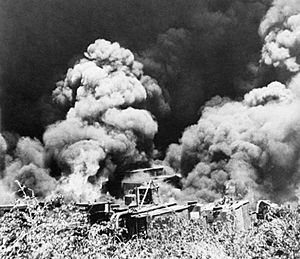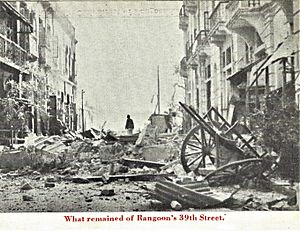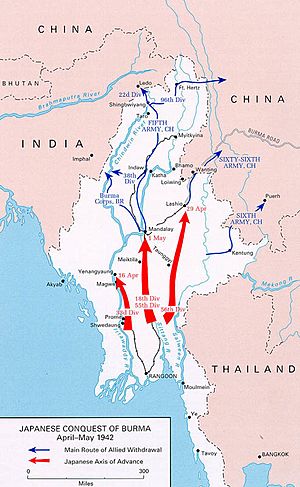Japanese invasion of Burma facts for kids
Quick facts for kids Japanese invasion of Burma |
|||||||||
|---|---|---|---|---|---|---|---|---|---|
| Part of the Burma Campaign in World War II | |||||||||
 View of the Yenangyaung oil field on 16 April 1942 after its destruction ahead of the Japanese advance |
|||||||||
|
|||||||||
| Belligerents | |||||||||
|
|
|
||||||||
| Commanders and leaders | |||||||||
|
|
||||||||
| Strength | |||||||||
| Casualties and losses | |||||||||
| More than 10,000–50,000 civilians killed | |||||||||
The Japanese invasion of Burma was the first part of the Burma campaign during World War II. This conflict lasted from December 1941 to May 1942. The Japanese Army, helped by Thai forces and Burmese fighters, pushed British Empire and Chinese troops out of Burma. After this, Japan took control of Burma and set up a new Burmese government.
Contents
Why the Invasion Happened
Burma Under British Rule
Before World War II, Burma was part of the British Empire. Britain had taken control of Burma after several wars in the 1800s. Burma was first ruled as part of British India. Later, it became a separate colony.
Burma saw a lot of economic growth under British rule. However, many Burmese people, especially the Bamar community, were unhappy. They worried about Indian workers coming in and changes to their traditional way of life. Many Burmese wanted independence. When Japan attacked, many Bamar people chose to help the Japanese instead of the British.
Britain's defense plans for its Asian lands, like Singapore and Malaya, were not ready for war with Japan. Burma was seen as a quiet area, not likely to be attacked. So, there were not enough soldiers or supplies to defend it well.
Japan's Goals for Burma
Japan entered World War II to get raw materials, especially oil. Many of these resources were in European-controlled areas in Southeast Asia. These areas were not well defended because of the war in Europe.
Japan wanted to attack Burma for several reasons. Burma had its own resources, like oil and minerals. Taking Burma would also protect Japan's main attacks on Malaya and Singapore. It would also create a safe zone for the lands Japan planned to take over.
Another key reason was the Burma Road. This road, finished in 1938, connected the port of Rangoon to China. It was used to send aid and weapons to Chinese forces fighting Japan. Japan wanted to cut off this important supply route.
The Japanese Fifteenth Army, led by Lieutenant General Shojiro Iida, was given the job of taking northern Thailand. Then, they were to attack Burma's southern province, Tenasserim.
Burmese Fighters Join In
As war became more likely, Japan looked for allies in Burma. In 1940, a Burmese student named Aung San met with a Japanese officer, Suzuki Keiji. Aung San and other volunteers, known as the Thirty Comrades, received military training in Japan.
The Burma Independence Army (BIA) was officially started in Thailand in December 1941. It began with 227 Burmese and 74 Japanese members. But as the Japanese invaded Burma, many more Burmese joined the BIA.
Japan Takes Rangoon
On December 22, 1941, the Japanese 55th Division began its attack. Their goal was to capture Moulmein. By January 23, 1942, Japan had taken key airfields in southern Tenasserim. This allowed Japanese planes to bomb Rangoon more easily.
Rangoon was first defended by small British air forces and American volunteer pilots, known as the "Flying Tigers". But as the Japanese took more airfields, Rangoon became harder to defend.
On January 22, 1942, the main Japanese attack began from Thailand. British and Indian troops guarding the area quickly fell back. The Japanese advanced to Moulmein, a city by the Salween River. The British 2nd Burma Brigade defended Moulmein. But it was hard to hold, with the wide Salween River behind them. On January 31, the British retreated across the river, leaving many supplies behind.
The Sittang Bridge Disaster
The British 17th Indian Division kept falling back north. They tried to hold defensive lines but were always outflanked. The division eventually retreated in disarray towards the bridge over the Sittang River. The retreat was slow due to broken vehicles and air attacks. Japanese soldiers also managed to get close to the bridge.
Fearing the Japanese would capture the bridge and use it to reach Rangoon, the British commander, Major-General "Jackie" Smyth, ordered it to be blown up. This happened on February 23, 1942. Most of the division was still on the enemy side of the river.
Many soldiers trapped on the wrong side swam or used rafts to cross the river. But they had to leave almost all their equipment behind. This decision to blow the bridge was questioned later. Some argued the river was not a big barrier, and blowing the bridge only delayed the Japanese by about ten days.
Rangoon Falls to Japan
Even though the Sittang River was a good defensive spot, the disaster at the bridge left the Allied forces too weak. General Archibald Wavell, the overall commander, still ordered Rangoon to be held. He expected more troops from the Middle East.
On March 7, the Burma Army left Rangoon. They destroyed the port and oil facilities to prevent the Japanese from using them. As the Allies left, the city was on fire.
The remaining British and Indian troops tried to retreat north from Rangoon. They faced being surrounded. But they managed to break through a Japanese roadblock. This happened because the local Japanese commander made a mistake. He pulled back his troops, not knowing the British were evacuating. If he had not, the Japanese might have captured many Allied soldiers.
Japan Pushes Onward
After Rangoon fell, the Allies tried to hold central Burma. They hoped the Chinese Expeditionary Force in Burma could defend a line south of Mandalay. The Chinese armies were large but had little equipment. Meanwhile, the new Burma Corps defended the Irrawaddy River valley.
The Japanese advance did not slow down. Instead, it sped up. Japan sent two more divisions to Burma. They also used many captured British trucks to move supplies quickly. The Japanese soon controlled the skies. Their bombers attacked almost every major town held by the Allies, causing much damage. The growing Burma Independence Army also troubled the Allied forces. Many Burmese soldiers left the British side.
The Allies also faced problems with the local government breaking down. Many people became refugees. People from India and mixed-race families fled to India, fearing the Japanese and some Burmese. Many poor families had to walk the whole way.
Lieutenant General William Slim, commander of Burma Corps, tried to fight back. But his troops were often outflanked and had to fight their way out of traps. The corps was slowly pushed north towards Mandalay. The 1st Burma Division was cut off at the oilfields in Yenangyaung. The Allies destroyed these oilfields to keep them from the Japanese. Chinese and British tanks rescued the division, but it lost almost all its equipment.
On the eastern front, the Chinese 200th Division held off the Japanese for a while near Toungoo. But after Toungoo fell, Japanese motorized troops quickly broke through. They captured Lashio, cutting off the Chinese armies from China. With the defense line broken, the Allies had to retreat to India or China.
The Difficult Retreat
The retreat was very hard. Starving refugees, lost soldiers, and the sick filled the rough roads to India. At least 500,000 civilians reached India. But many thousands, possibly between 10,000 and 50,000, died on the way. Many who reached India suffered from diseases like dysentery and malaria.
On April 26, British, Indian, and Burmese forces joined the full retreat. The Burma Corps retreated to Manipur in India. On May 12, the Japanese took Kalewa. They had covered 1,500 miles in 127 days, fighting 34 battles.
Burma Corps reached Imphal in Manipur just before the heavy monsoon rains began in May 1942. The soldiers lived outdoors in very unhealthy conditions. The authorities in India were slow to help the troops and refugees. Many soldiers were in a terrible state.
The British government of Burma had moved to Myitkyina in Northern Burma. Many British and Indian civilians went with them. The governor and some important civilians were flown out. But most refugees had to walk to India through difficult valleys and mountains. Many died. Some reports say that civil authorities allowed white and Eurasian civilians to go ahead, while stopping Indians. This led to many deaths.
The Japanese advance cut off many Chinese troops from China. Many also retreated to India. They often took supplies from others, making the refugees' lives even harder. However, the Chinese 38th Division, led by Sun Li-jen, fought its way to Imphal, arriving mostly intact. The American General Joseph Stilwell also walked to Imphal. The remaining Chinese troops tried to return to China through the mountains, but many died.
The 23,000 Chinese soldiers who reached India were put under General Stilwell's command. They were trained and given new equipment by American instructors.
End of the Campaign
The Japanese 18th and 56th Divisions chased the Chinese into China. But they were ordered to stop at the Salween River on April 26. The Japanese 33rd Division also stopped at the Chindwin River in late May. This ended the invasion until the monsoon rains finished.
In the coastal Arakan Province, some Burmese fighters reached Akyab Island before the Japanese. However, they also caused fighting between different groups of people in the province. The Japanese advance in Arakan stopped just south of the Indian border. This led the British to destroy some areas to prevent the Japanese from using them. This action contributed to the Bengal Famine of 1943.
Thailand Takes Control of Shan States
On December 21, 1941, Thailand signed a military agreement with Japan. On March 21, 1942, Japan agreed that Kayah State and the Shan States would be under Thai control. Thai forces entered the Shan States on May 10, 1942. Three Thai divisions, supported by their air force, captured Kengtung on May 27. The Chinese 93rd Division, already cut off by the Japanese, was retreating.
On July 12, 1942, a Thai division began to take over Kayah State. They drove the Chinese 55th Division from Loikaw. The Thai forces remained in control of these areas for the rest of the war. Their troops faced supply shortages and disease, but they were not attacked by the Allies.
During the Japanese invasion, Panlong Subtownship, a Chinese Muslim town in British Burma, was completely destroyed. The Hui people of Panlong formed a self-defense group. The Japanese burned Panlong, forcing over 200 Hui families to flee as refugees.
Images for kids
See also
- Burmah Oil Co Ltd v Lord Advocate – a landmark 1965 court case on the scope of prerogative power arising from the invasion




